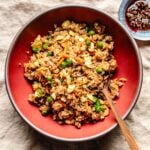Panda Express fried rice recipe
This Panda Express Fried Rice recipe is easy, economical, and tastes delicious with crisp rice grains & veggies.
Servings: 6 servings
Ingredients
- 3 cups cooked jasmine rice refrigerated and cold, or use long grain or medium-grain white rice
- 2 large eggs
- ½ tsp coarse sea salt plus more to taste
- ½ tsp Shiitake mushroom bouillon or chicken bouillon, ¼ tsp msg
- ½ tsp garlic powder
- ¼ tsp white pepper
- 1 tbsp light soy sauce or 1 tbsp coconut aminos
- 0.5 tbsp dark soy sauce or 0.5 tbsp coconut aminos
- 2 tsp toasted sesame oil
- ½ tsp coconut brown sugar or keto white sugar, optional
- 1.5 tbsp avocado oil divided
- 1 cup frozen mixed vegetables peas and carrots
- 1 bulb green onion diced
Instructions
- Set aside the cooked rice in one large bowl. Whisk the eggs in a separate small bowl. Add the dry spices in a small bowl with salt, mushroom bouillon, if using, garlic, and white pepper. The sauce combo in another bowl with light and dark soy sauce, sesame oil and sugar, if using.
- Preheat a large 12-inch saute pan (or wok) over medium heat until it feels warm when placing your palm near. Add 0.5 tbsp oil and pour in the eggs. Gently stir to make soft scrambled eggs, keep the texture tender, 10 seconds then transfer the eggs out and set aside in a bowl.
- Add 1 tbsp oil and add in the rice little-by-little while using your hands to gently separate the rice grains (I wear a cooking kitchen glove to do this). By doing some, the rice grains are less likely to clump and therefore each grain cooks evenly. Turn heat up to medium-high.
- Use a wooden spoon or spatula to scoop the rice from bottom up and repeat the motion to toss the grains without smashing them. This scooping motion also helps the moisture to evaporate and keeps the rice grains crisp. You should hear the sizzling sound. If not, turn the heat up a bit more.
- When you see the rice grains start popping, that means the grains are no longer wet, about 3-4 minutes, add the peas and carrots and season the rice with salt, garlic powder, shiitake bouillon, if using, and white pepper, toss for 10 seconds.
- Turn heat up to high and push the ingredients to the side of the pan, add the light and dark soy sauce and sesame oil to the center of the pan. The sauce will immediate sizzle as soon as it hits the hot pan and creates a nice aroma. Quickly fold the rice in to coat with the sauce and toss everything to combine until the rice grains are no longer wet, 2-3 minutes. The pan will be really hot so be careful as you cook.
- Return the eggs to the pan and use your spatula to break up the eggs while tossing and scooping. Turn off the heat. Transfer to a large serving plate. Garnish with green onions. Serve warm.
Video
Notes
- If using coconut aminos instead of soy sauce, skip the added sugar—it's naturally sweeter.
- Success in fried rice lies beyond just using day-old, cold rice; it's crucial to consider the order, timing, and temperature of your cooking.
- To prevent clumping and ensure even cooking, gently separate the refrigerated rice grains with your hands before adding them to the pan.
- While a wok isn't necessary, it does add a unique smoky flavor known as 'wok hei.' However, a large pan can also achieve crispy rice grains by providing ample cooking surface.
- High heat is essential to keep the ingredients crisp and avoid soggy rice, key for that perfect fried rice texture.
- When cooking rice, aim for grains that are cooked through yet firm, avoiding mushiness. After cooking, fluff the rice and let it cool to room temperature before refrigerating loosely covered, to prevent the grains from smashing together. This prep ensures the rice is in optimal condition for frying.
Nutrition
Serving: 1serving | Calories: 195kcal | Carbohydrates: 27g | Protein: 6g | Fat: 7g | Saturated Fat: 1g | Polyunsaturated Fat: 2g | Monounsaturated Fat: 4g | Trans Fat: 0.01g | Cholesterol: 62mg | Sodium: 449mg | Potassium: 130mg | Fiber: 2g | Sugar: 0.4g | Vitamin A: 1632IU | Vitamin C: 3mg | Calcium: 26mg | Iron: 1mg
